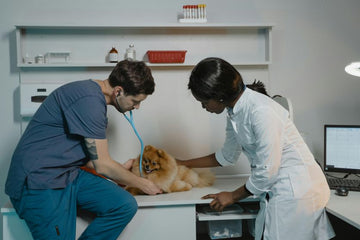Training your senior dog can be just as fulfilling as training a younger pup, but it requires a tailored approach to accommodate their unique needs. As dogs age, their physical and cognitive abilities may change, influencing their response to training and their treat preferences. Choosing the right training treats for older dogs can make all the difference in ensuring that training sessions are both enjoyable and effective.
This guide explores what to consider when selecting training treats for senior dogs and offers tips for making the training process a positive experience for your aging companion.
Understanding the Needs of Senior Dogs
Senior dogs, like senior humans, face age-related changes that can impact their health and behavior. These changes influence their training requirements and the types of treats that are most suitable. Here are some common considerations for senior dogs:
- Reduced Mobility: Older dogs may have joint pain, stiffness, or arthritis, making certain movements or positions more challenging.
- Cognitive Changes: Senior dogs may learn more slowly and require extra repetition and patience during training.
- Dental Issues: Missing teeth, gum disease, or general sensitivity can make hard treats difficult or uncomfortable to chew.
- Dietary Restrictions: Many senior dogs face conditions like diabetes, kidney disease, or weight gain, necessitating specialized diets and low-calorie treats.
By understanding these factors, you can choose treats that align with your dog’s specific needs and make training a safe, enjoyable activity.
What to Look for in Training Treats for Senior Dogs
1. Soft and Easy to Chew
Dental health is a common concern for senior dogs, so treats that are soft or easily crumbled are ideal. Soft treats are gentle on aging teeth and gums, making them easier and more enjoyable for your dog to consume.
Look for treats labeled as “soft and chewy” or those that can be broken into smaller pieces with minimal effort. Avoid hard biscuits or crunchy snacks unless your senior dog can handle them comfortably.
2. Small and Bite-Sized
Bite-sized treats are perfect for training because they allow for frequent rewards without overfeeding. Smaller treats are especially important for senior dogs, as they may have smaller appetites or slower metabolisms.
Choose treats designed for training, as they are often smaller and easier to portion. Alternatively, you can break larger treats into smaller pieces to make them more suitable for your dog.
3. Low-Calorie and Nutritionally Balanced
As older dogs are often less active, they require fewer calories to maintain a healthy weight. Low-calorie treats help prevent unnecessary weight gain while still providing a motivating reward during training.
Look for treats with simple, wholesome ingredients that provide balanced nutrition. Avoid treats with added sugars, fillers, or artificial ingredients, which can contribute to health issues.
4. High-Quality Ingredients
Digestive sensitivity is common in senior dogs, so choose treats made from natural, whole food ingredients. Opt for treats with real meat, vegetables, or whole grains and avoid those containing common allergens like wheat, soy, or corn if your dog has sensitivities.
Treats with limited ingredients are a great choice, as they reduce the risk of upsetting your dog’s stomach.
5. Appealing Flavors for Seniors
Senior dogs may experience a diminished sense of smell or taste, so treats with strong, appealing flavors are more likely to capture their interest. Popular options include chicken, beef, turkey, or fish-based treats.
Experiment with different flavors and textures to find the ones your dog enjoys most. Variety can keep training sessions exciting and engaging for your senior pup.
6. Functional Treats for Added Benefits
Functional treats are designed to offer health benefits in addition to being tasty rewards. For senior dogs, consider treats with:
- Glucosamine and Chondroitin: To support joint health and mobility.
- Omega-3 Fatty Acids: For cognitive health and a healthy coat.
- Probiotics: To aid digestion and boost gut health.
These treats can enhance your dog’s overall well-being while keeping them motivated during training.
Training Tips for Senior Dogs
Training a senior dog requires a slightly different approach than working with younger dogs. Here are some tips to ensure success:
1. Keep Sessions Short and Fun
Senior dogs may have shorter attention spans or tire more easily. Aim for brief training sessions (5-10 minutes) with frequent breaks.
2. Use Positive Reinforcement
Older dogs respond well to positive reinforcement, such as verbal praise, gentle petting, or toys, in addition to treats. This combination strengthens their bond with you and reinforces desired behaviors.
3. Be Patient
Senior dogs may need extra time to learn new commands or adjust to changes in routine. Offer plenty of encouragement and avoid rushing the process.
4. Adapt to Physical Limitations
Modify training exercises to accommodate your dog’s physical abilities. For instance, if your dog struggles with sitting due to arthritis, teach them to “touch” or “lie down” instead.
5. Prioritize Comfort
Ensure your dog is comfortable during training by working on soft surfaces and avoiding strenuous activities that could exacerbate joint pain or fatigue.
Examples of Senior-Friendly Training Treats
Here are some examples of treats that work well for senior dogs:
- Soft Treats: Chewy treats made with simple, wholesome ingredients.
- Freeze-Dried Meat: Lightweight and easy to chew, freeze-dried chicken or turkey is a high-value reward.
- Homemade Treats: Try baking soft training treats using senior-friendly ingredients like pumpkin, oatmeal, and peanut butter.
- Fresh Foods: Small pieces of cooked chicken, sweet potato, or apple (without seeds) are great low-calorie options.
Conclusion
Training a senior dog can be a rewarding experience that strengthens your bond and keeps your dog mentally stimulated. Choosing the right training treats is key to ensuring that the process is enjoyable and health-conscious. Look for soft, small, low-calorie options made from high-quality ingredients, and consider functional treats that offer added health benefits.
By tailoring your training approach and treats to your senior dog’s unique needs, you can create a positive experience that keeps your aging companion happy, engaged, and motivated. With patience and thoughtful planning, you can continue to enjoy the joy of training and learning together, no matter your dog’s age.




